Triboelectric Generators
February 8, 2016
Thales (c. 624 - c. 546 BC) was one of the first
Greek philosophers interested in
physics, and his work is known to us only through the works of other philosophers, including
Aristotle. In his
Politics, Aristotle tells an interesting
anecdote about Thales.
"He was reproached for his poverty, which was supposed to show that philosophy was of no use. According to the story, he knew by his skill in the stars while it was yet winter that there would be a great harvest of olives in the coming year; so, having a little money, he gave deposits for the use of all the olive-presses in Chios and Miletus, which he hired at a low price because no one bid against him. When the harvest-time came, and many were wanted all at once and of a sudden, he let them out at any rate which he pleased, and made a quantity of money. Thus he showed the world that philosophers can easily be rich if they like, but that their ambition is of another sort."[1]

Thales of Miletus
(c. 624 - c. 546 BC)
Thales promoted a separation of religion and science by looking for natural explanations for phenomena, rather than invoking the gods. He is also credited with Thales' theorem that any angle inscribed in a semicircle is a right angle.
(Woodcut from the Nuremberg Chronicle (1493), via Wikimedia Commons.)
The first example of
electricity known to man was
static electricity. While it must have been observed long before his time, Thales wrote the first description of
triboelectricity; that is, electricity generated by rubbing
materials together. He observed that some combinations of materials, such as
rabbit fur and amber, were better at producing
sparks than others. In fact,
electron comes from the
Greek word for amber, ηλεκτρον. Thales observed the basics of what we now call the triboelectric series, as illustrated below.
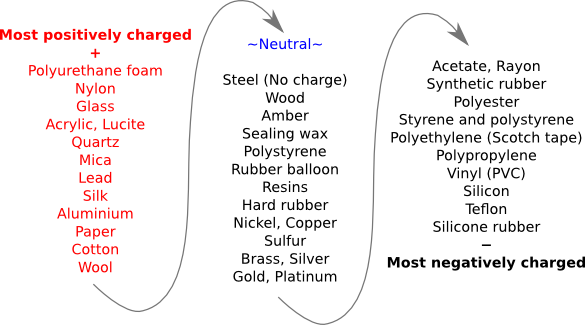
The triboelectric series, drawn using Inkscape from Wikipedia data.)
Electricity is produced, of course, by
electrons, and the triboelectric series ranks the electron donor and acceptor ability of materials. Items high on the above list have a tendency to donate electrons to items lower on the list, and the separation of materials on this list indicates the
intensity of the triboelectric effect. The triboelectricity of amber was cataloged by
Theophrastus (c. 371 - c. 287 BC) a little more than two centuries after Thales in his book,
On Stones (see figure). Theophrastus considered triboelectricity to be a form of
magnetism.

Portion of "On Stones," a discourse on minerals (c. 300 BC) by Theophrastus, mentioning the attractive property of amber.[2]
It took two thousand years before someone tried to generate triboelectricity continually by
machine.
James Wimshurst (1832-1903), a
nineteenth century British engineer, designed and built his Wimshurst machine (see figure). The Wimshurst machine rubbed two disks together to generate a static electrical charge that was collected by metal patches and directed to electrodes.
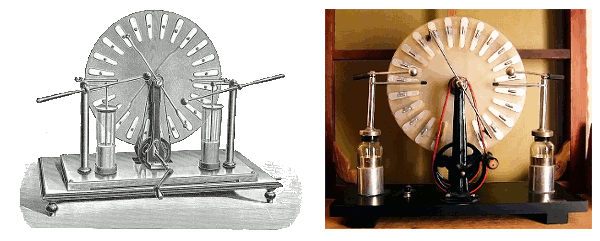
The Wimshurst machine. Left image, a scan by Andy Dingley from the 1903, Electrical Installations (Volumes V) by Rankin Kennedy, Caxton Press, London. Right image, a modern replica. Images from Wikimedia Commons)
Early nuclear physics experiments required
high voltages to
accelerate particles to high
energies, and this inspired
Robert Van de Graaff(1901-1967), a
Princeton University physics
professor, to develop his eponymous
Van de Graaff generator, as shown in the figure. Just as in its lesser cousin, the Winshurst machine, rubbing of materials in the Van de Graaff generator produced high voltages.
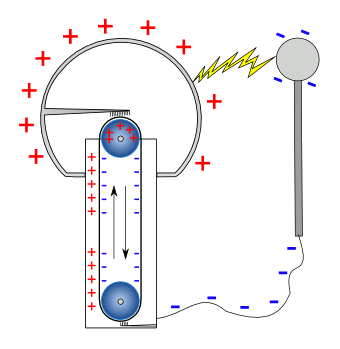
Diagram of a Van de Graaff generator
In this device, a pulley acts as one member of a triboelectric couple with an insulating belt.
Charge is transferred through small gaps between the belt and the brushes.
(Modified Wikimedia Commons image).)
While
piezoelectricity gets more attention as an electrical generator than triboelectricity for
environmental energy-harvesting applications, Zhong Lin Wang and his
research team at the
Georgia Institute of Technology (Atlanta, GA) have been doing research on making useful triboelectric devices. I wrote about one aspect of this research in an earlier article (Triboelectric Generators, July 25, 2012).
In 2012, the Georgia Tech team developed a triboelectric generator made from a sheet of
polyester, a electron donor, that rubs against a sheet of polydimethylsiloxane, an electron acceptor.[3-4] Continually rubbing and separating the micropatterned sheets generates a small alternating current of nearly 20 volts with a current of about 0.10 microamps per square centimeter.[2-3] This calculates out to a peak power of 2 microwatts per square centimeter.
Fast forward several year to the present, and the Georgia Tech research group has team with others at
Tsinghua University (Beijing, China) to increase the
efficiency of such triboelectric generators. In a recent paper in
Nature Communications, they report a highly efficient triboelectric power system using
biomechanical energy to power
mobile electronics.[5-6]
This system combines a high-output triboelectric nanogenerator, a power management circuit for
conversion of the generated
alternating current to
direct current at 60% efficiency, and an
energy storage device.[5] A mere tapping of a
palm produces more than a milliwatt of continuous power in a device with a conversion factor of 7.34 watts per
cubic meter.[5]
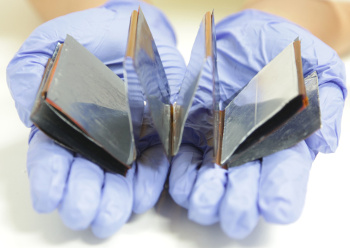
Georgia Tech triboelectric nanogenerator based on the triboelectric effect and electrostatic induction.
(Georgia Tech image from the Zhong Lin Wang Laboratory.)
This system overcomes the main drawbacks of triboelectric energy-harvesting, alternating current (AC) generation at high voltage and low
current, and intermittancy. Electronic circuitry runs on direct current (DC) of low voltage and high current. The system captures the AC signal in a first
capacitor, and a power management circuit transforms the energy into a DC voltage to charge a
battery or larger capacitor.[7]
The power management circuit needs some power to operate, and there's a requirement that the triboelectric source needs to produce at least 100 microwatts. With this condition met, the circuitry can transform energy at milliwatt levels.[7] The next goal is the miniaturization of the circuitry. The Georgia Tech team has made triboelectric generators that operate in many
mechanical modes, including vertical contact separation and lateral sliding.[7]
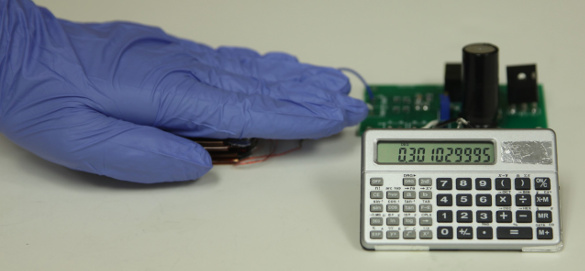
Calculator powered by finger tapping using the Georgia Tech triboelectric nanogenerator and the two-stage power management and storage system. (Georgia Tech image from the Zhong Lin Wang Laboratory.)
As one example of triboelectric environmental energy-harvesting, the Georgia Tech team has used a flapping
flag to harvest
wind energy.[8-9] The rubbing materials in this flag are
nickel-coated
polyester and
polyimide-coated
copper film. The 15
gram flag generates about 40 volts at 30 microamperes at a wind speed of 22
meters per second.[8] This calculates out to a little more than a milliwatt of power.
References:
- Aristotle, Politics, Book I, Part XI, via MIT Classics.
- Earle Radcliffe Caley and John F.C. Richards, "Theophrastus on Stones: Introduction, Greek Text, English Translation, and Commentary," Ohio State University (Columbus, Ohio, 1956). Greek text, p. 23; English translation, p. 51, as follows: "... And since amber is also a stone—for the kind that is dug up is found in Liguria—the power of attraction would belong to this too. The stone that attracts iron is the most remarkable and conspicuous example. This also is rare and occurs in few places. This stone too should be listed as having a similar power."
- John Toon, "Plastic Power: Triboelectric Generator Produces Electricity by Harnessing Frictional Forces Between Transparent Polymer Surfaces," Georgia Tech Press Release, July 9, 2012.
- Feng-Ru Fan, Long Lin, Guang Zhu, Wenzhuo Wu, Rui Zhang, and Zhong Lin Wang, "Transparent Triboelectric Nanogenerators and Self-Powered Pressure Sensors Based on Micropatterned Plastic Films," Nano Letters, vol. 12, no. 6 (June 13, 2012), pp. 3109-3114.
- Simiao Niu, Xiaofeng Wang, Fang Yi, Yu Sheng Zhou, and Zhong Lin Wang, “A universal self-charging system driven by random biomechanical energy for sustainable operation of mobile electronics,” Nature Communications, vol. 6, article no. 8975 (December 11, 2015), doi:10.1038/ncomms9975. This is an open access paper with a PDF file available here.
- Film clips associated with ref. 5, from the Nature Commons Web Site.
- Two-Stage Power Management System Boosts Energy-Harvesting Efficiency, Georgia Institute of Technology Press Release, January 11, 2016.
- Prachi Patel, "Fluttering Flag Generates Power From Wind," IEEE Spectrum, January 13, 2016.
- A multitude of Zhong Lin Wang's publications at ACS Nano.
Permanent Link to this article
Linked Keywords: Thales (c. 624 - c. 546 BC); Ancient Greek philosophy; Greek philosopher; physics; Aristotle; anecdote; poverty; philosophy; astrology; skill in the stars; winter; harvest; olive; money; deposit; olive-press; Chios; Miletus; wealth; rich; ambition; religion; science; nature; natural; phenomenon; phenomena; deity; god; Thales' theorem; angle; semicircle; right angle; Nuremberg Chronicle (1493); Wikimedia Commons; electricity; static electricity; triboelectric effect; triboelectricity; material; rabbit fur; amber; electric spark; electron; Greek language; Greek word; triboelectric series; Inkscape; electron; intensity; Theophrastus (c. 371 - c. 287 BC); century; On Stones; magnetism; mineral; amber; machine; James Wimshurst (1832-1903); nineteenth century; British; engineer; Wimshurst machine; metal; electrode; >replica; nuclear physics; experiment; high voltage; particle accelerator; accelerate particles; energy; energies; Robert Van de Graaff(1901-1967); Princeton University; professor; Van de Graaff generator; pulley; insulator; insulating; electric charge; brush; piezoelectricity; environmental energy-harvesting; Zhong Lin Wang; research; Georgia Institute of Technology (Atlanta, GA); polyester; polydimethylsiloxane; micropatterned; alternating current; volt; ampere; microamp; square centimeter; microwatt; Tsinghua University (Beijing, China); energy conversion efficiency; Nature Communications; biomechanics; biomechanical; mobile electronics; energy conversion; direct current; energy storage; palm; cubic meter; electrostatic induction; electric current; capacitor; battery; mechanical mode; calculator; flag; wind power; wind energy; nickel; polyester; polyimide; copper; gram; meters per second.